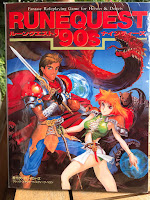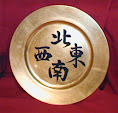The
Kickstarter project for
13th Age in Glorantha has been live since the day before yesterday and it has already funded — just as I had predicted. However,
13th Age in Glorantha is
not merely an adaptation of the rules and of the icons of
13th Age to allow GMs and players to play in Glorantha. I'll explain you why, but first— some history.
RuneQuest, the very first Gloranthan role-playing game, by
the Chaosium, was set in the Third Age of Glorantha. The RuneQuest rules do not indicate any clear "canonical" date for playing, but the time-line on page 7 ends with the following entry:
1613 - Starbrow leads another Sartarite rebellion, quickly crushed by the Empire.
so we may consider that the implied time frame of the setting was
the late 1610s.
The second Gloranthan role-playing game,
RuneQuest by
Avalon Hill, doesn't indicate any canonical date for playing either. The Glorantha chapter of RQ3 indicates that:
Gloranthan supplements to come take place during the beginning of the Hero Wars
which puts the corresponding time-frame at
1621~1625.
After a long hiatus, Gloranthan role-playing came back to us fans in the form of the
Hero Wars role-playing game by
Issaries. Given its title, you would have presumed that
Hero Wars was set during the Hero Wars, yet in reality it was set just before them: it is mentioned that the Lunar Empire conquered Dragon Pass 20 years before present. Since that happened in 1602, it results that Hero Wars is set in
1622.
The imperfect
Hero Wars game was followed quite closely by the much perfected
HeroQuest, which stated:
HeroQuest is a Game of Adventure. The game is set during the Hero Wars.
However, further supplements quite clearly set the game at the beginning of the Hero Wars, meaning a time-frame of
1621~1625 again, much like RQ3.
The next Gloranthan role-playing game in line was the
Mongoose version of
RuneQuest. MRQ was set in the Second Age of Glorantha (fantastic idea) but the game alienated the fan base with error-ridden books and too many departures from canon.
In parallel,
HeroQuest by
Moon Design grew and prospered. It is now canonically set in the year
1621, according to page 111 of the 'canonest' book of all, the
Guide to Glorantha:
The current year is 1621 ST.
So, in a nutshell: we've heard and read so much about the Hero Wars in the last 30+ years, but the latest any Gloranthan role-playing game has ever let us play was actually
1625.
Enter
13th Age in Glorantha. According to its Kickstarter page, the setting of the game will be Peloria and Maniria. But, more interestingly, the KS project does not simply entail a book explaining how to play
13th Age in Glorantha, it will also entail a second book with lots of fantastic new system-agnostic stuff. Let me quote from
the KS page:
We are also introducing The Glorantha Source Book, a 128+ page full-colour hardcover book that is the perfect companion to the 13th Age in Glorantha rulebook. Containing no gaming rules, it is a wonderful resource for people wanting to begin their journey into the mythic world of Glorantha.
The Glorantha Source Book will include:
- Introduction to Glorantha and the Runes
- Cosmology, History, and a summary of the Gods of Glorantha
- Overview of the major regions of the world with a focus on Dragon Pass and surrounding lands
- Who's who in the Hero Wars – the dramatic conflict at the end of the Third Age of Glorantha!
On the Gloranthan G+ community, Jeff added the following:
The Glorantha Source Book will be set in 1627 during the Dragon Pass Hero Wars.
Yup,
1627, the latest
any Gloranthan role-playing game will let us play and, at last,
during the Hero Wars, not just before them!










